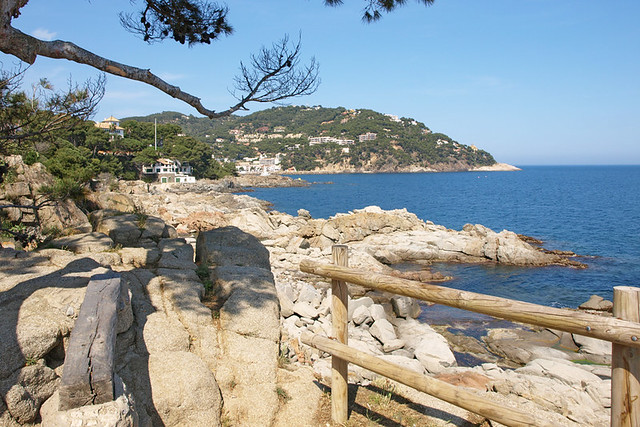First of all what are warm winter walking temperatures anyway?
For us, ideal temperatures would probably be around 17/18C, but a couple of degrees cooler is also extremely pleasant for walking, maybe even better.
Does that sound a bit on the cool side? If you think so, there are a couple of things to consider. Those temps might feel on the cool side if you’re lying on a sunbed, but when you’re huffing and puffing your way up a hillside they’ll have the sweat glands pumping. More importantly, and something a lot of folk don’t consider, is that average temperatures are shade temperatures. In full sunshine it’s an awful lot hotter. Yesterday (a November day if you’re reading this in the future and it’s July) we walked in 19C on a cape just south of Lisbon. There was no shade and it was perfect for hiking; tee-shirt weather, but bordering on hot any time we had to ascend slightly.

This is the time of year when there are regular travel articles about warm winter walking. Generally they’ll feature the same handful of locations. Carrying out some research as to what others considered winter walking destinations in Europe, I came across a Telegraph article where three travel writers answered a reader’s question about ideal destinations for some winter warm sunshine on the trail. One advised La Palma, Gran Canaria, and La Gomera. Another suggested Madeira. And the third went for somewhere different in Cyprus and Sicily. Apart from the last two, the others are classic, well known winter walking destinations. Sicily, I’m not so sure about as average temps of around 9/10C between December and February don’t constitute warm winter walking in my book.

What was particularly interesting was how even experienced travel writers are influenced by the travel industry. There can be a big element, just as there is with the fashion world/food etc, of the industry pointing us in the directions they want us to take rather than showing what’s actually available which fits the warm winter walking remit i.e. places in Europe where the temperatures make for pleasant walking during the coolest winter months (Dec to Feb).
In reality there are significantly more options than the ones regularly rolled out.

Warm winter walking in Spain
The Canary Islands are ideal for warm winter walking. All of them, not just the three mentioned previously (I suspect there was a bit of snobbery involved there as walking on Tenerife offers some of the best hiking in the Canaries in our view). We do think the western Canary Islands (Tenerife, La Palma, El Hierro, and La Gomera) and Gran Canaria offer the best walking, but they’re all good. Temperatures don’t vary much between them – averaging around 18 to 20C mark. However, the best walking tends to take place in the hills and mountains and the higher you go the cooler it gets. That doesn’t matter when the sun is shining, but it makes a difference when it isn’t. Although not as dramatic or challenging walking, the eastern islands tend to have the least rainfall, but it’s all relative. These islands have as perfect a climate as you can get.
Then there’s the Balearics. In truth I haven’t walked on them in winter but I have been on a beach holiday to Mallorca in January when I was 18. Young, dumb, and in the sun. Admittedly, being Scottish, my idea of what was warm then is way different than it is now, but it certainly felt like sunbathing weather to us so it would be perfectly good for walking. Average temps show it to be around 14-16C in the Balearics in the winter months.

Not to be discounted is Spain’s southern coastal areas. In Costa Brava temperatures are borderline 13/14C average but rainfall is relatively low, whilst around Costa Blanca it’s a steady 16C, again with low rainfall.
Warm winter walking in Portugal
As mentioned previously, Madeira is another classic warm winter walking destination, and another we haven’t visited. Living in the Canary Islands for over a decade we always opted for other destinations we thought would be more different than the landscapes we were used to. Temperatures are slightly cooler than its neighbouring archipelago, but at around 16C they’re still perfect for warm winter walking.

Although further north, the Algarve shares similar temperatures with Madeira, but has less rainfall. We’ve walked coastal and inland routes in the Algarve in late November and in February. At the coast in November it was still sunbathing weather and could have been too hot if the walking was more challenging than it was. Inland around Monchique in February the weather was perfect for walking.
Where the Algarve does sometimes get recommended as winter walking destination, further north generally doesn’t. And yet in the Setúbal Peninsula just south of Lisbon temperatures are on a par or even slightly higher than those of the Algarve, and rainfall is slightly less. We love walking in Arrábida Natural Park in the winter months as it is far more comfortable walking than in late spring/early autumn.

Warm winter walking in other parts of Europe
As suggested by the Telegraph, Cyprus has average winter temperatures between 14-16C making it perfectly acceptable. Malta and Gozo come in at around 15-16C; also good. Further north and east in the Mediterranean and the temperatures drop; although, on Crete you find virtually the same winter temperatures as Cyprus, on the same latitude.

Looking at average temperatures is a basic litmus test. There are various other factors to take into account before turning up wearing walking shorts and short-sleeved tops at a destination where graphs show warm winter temperatures – e.g. finding out what’s actually open out of main holiday seasons.
The bottom line is there’s a bigger choice of warm winter European walking destinations than is often suggested.

Be the first to comment